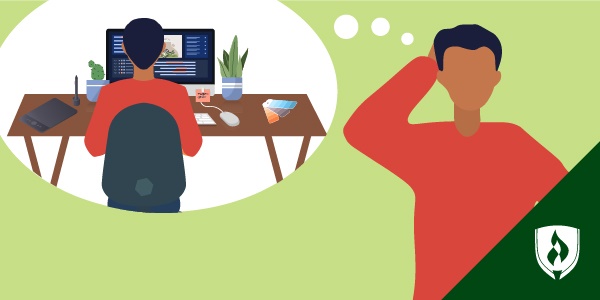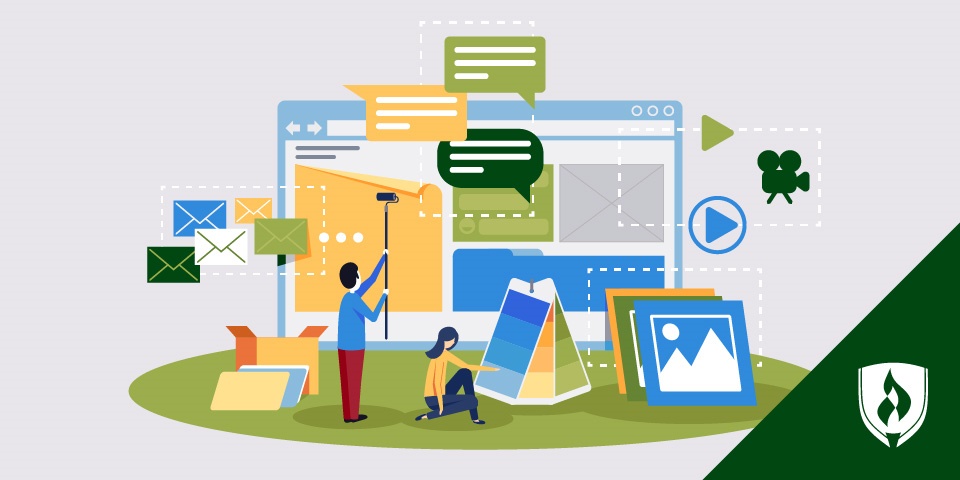
“Choose a job you love and you will never have to work a day in your life.” -Anonymous
Figuring out what you want to do with the rest of your life isn’t easy, but it can’t hurt to start your search by focusing on things you actually like to do while you map out your journey.
If you’re a creative, tech-savvy individual with an artistic background, you’ve probably considered working in graphic design. Careers in this field will allow you to exercise your imagination alongside your technical skills on a daily basis.
But a graphic designer is a graphic designer, right? Not so fast—there’s a variety of creative careers that are either closely associated with graphic design or have a significant overlap in the skills and abilities needed to do the work. In this article, we will take a closer look at eight specialized graphic design-related positions you may not be aware of. Familiarizing yourself with these opportunities will give you a better idea of how your graphic design career path could take shape.
8 Different types of graphic design-related jobs to consider
Advancements in technology have drastically changed the graphic design industry. While you can still be a jack-of-all-trades and dabble in multiple facets of the field, more opportunities are emerging for specialists to thrive.
What’s more, in many cases, designers with specialized skills have the potential to earn a higher salary than those with generalized skills. This means you won’t have to choose between personal satisfaction and financial stability when it comes to narrowing your career path.
Take a look at these eight graphic design jobs you may not have considered.
1. Creative services manager
The work of a creative service manager can vary depending on employers, but in general they act as a liaison between senior management and the creative professionals they oversee. This role requires considerable experience—often creative service managers are promoted from the ranks of graphic designers or other creative professionals.
In their day-to-day work, they oversee entire creative projects and guide a team of creative professionals to ensure all deadlines are met and budgets are honored. This means you’ll need strong people skills and management abilities to pair with design talent. Creative services managers may take on some of the hands-on design work load but are generally a little less involved with the day-to-day creative production tasks.
2. Email marketing designer
These professionals are tasked with designing and executing engaging email communications and promotions for an organization. Email marketing designers work closely with other designers, user interface specialists, writers and marketing managers to ensure strategies are fulfilled and brand standards are upheld.
It is important for email marketing designers to understand the principles of design and user experience while also maintaining significant knowledge and experience with HTML and CSS as they may be asked to code the final creative product.
3. Art director
This is another creative career option for experienced graphic designers. Art directors are responsible for the overall look and feel of a project, campaign or even brand. This role requires an excellent eye for detail as it is their job to ensure every piece of work created supports a project and is cohesive and fits with the overall creative vision. Everything from the typefaces used to the style of clothing worn by models in promotional shoots falls under their purview.
Art directors work closely with clients or internal management teams to gather information about the brand and the desired target audience of their work. With this information, art directors craft the creative framework and standards designers adhere to.
4. Information architect
Information architects help clients define content strategy and design features for websites. In an effort to improve website design and user experience, they specialize in analyzing the needs of a prospective audience. Information architects work to ensure users can intuitively find the things they’re looking for.
Just as traditional architects draw up plans for the layout and structure of buildings, information architects use wireframes, process maps and mock-ups to describe the intended user experience for websites and apps. They also conduct usability testing on working prototypes or finished products to improve architecture and navigation.
5. Mobile designer
The pros operating under this job title design content and functionality specifically for mobile platforms like phones or tablets. This is especially important in our contemporary digital age, as more and more people are using mobile devices to access the internet.
Mobile designers collaborate with cross-functional teams to create compelling, interactive experiences on mobile devices. These designers must be well versed in both the aesthetic and functional aspects of web and mobile design, and fluency across multiple platforms and programming languages is ideal for individuals in this position.
6. Motion designer
Motion designers bring visuals to life on the internet, on television and in film. These members of a creative team use their animation skills to tell important stories with eye-catching visuals. This could take the form of a flashy introductory animation on the home page of a website, a transition effect on a newscast or an animated video on YouTube® explaining how to use a product.
There are several good reasons to believe brands and advertisers will place an emphasis on online video channels as another avenue for capturing the attention of consumers, which could indicate a bright future for designers specializing in animation and motion graphics.
7. User experience (UX) designer
UX designers’ primary purpose is to create satisfying or captivating experiences for an audience based on user research and workflow analysis. They are often responsible for generating personas, usage scenarios, sitemaps, wireframes and other tools to help create a positive user experience.
These specialists also conduct usability testing on prototypes or finished products to assess the quality of the user experience. An in-depth understanding of web technologies and graphic design is a must in this position.
8. User interface (UI) designer
UI designers build the application interfaces that connect users to back-end processes and data. They enable users to quickly accomplish their goals by providing code that meets usability and accessibility standards.
These specialists tend to work closely alongside a development team to create and enhance interactive applications and web pages. Most UI designers have expertise in a wide array of web technologies, such as Ajax, CSS, HTML and JavaScript™.
Is your future in one of these graphic design jobs?
As you may be realizing, there is so much more to graphic design than just logos and layouts. If you’re looking to launch a fulfilling design career that can also help pay the bills, then these specialist positions could be the answer you’ve been looking for. You can keep your creative life cultivated while also making a living in a career you love.
Learn more about how a Graphic Design degree can help prime you for success in one of these positions by reading our article, “Is a Graphic Design Degree Worth It or Worthless?”. Additionally, check out everything you need to know about digital design.
EDITOR’S NOTE: This article was originally published in May 2014. It has since been updated.




